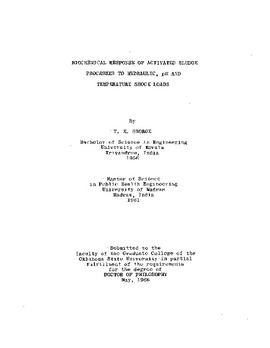| dc.contributor.advisor | Gaudy, A. F., Jr. | |
| dc.contributor.author | George, T. K. | |
| dc.date.accessioned | 2016-02-16T20:23:22Z | |
| dc.date.available | 2016-02-16T20:23:22Z | |
| dc.date.issued | 1968-05 | |
| dc.identifier.uri | https://hdl.handle.net/11244/30325 | |
| dc.description.abstract | Scope and Method of Study: The biochemical response of a continuous flow completely mixed activated sludge system to shock loadings consisting of changes in dilution rate, pH and temperature was investigated using glucose as the organic carbon source. Changes in dilution rate were studied under two different conditions, i.e., with constant influent organic concentration and constant daily organic loading. The effect of changes in reactor pH was investigated under conditions in which cells were recycled, as well as in "one pass" flow through systems. The response to changes in temperature of the mixed liquor in the aerator was studied at two different reactor detention times, eight hours and four hours. | |
| dc.description.abstract | The major parameters studied included biological solids concentration, effluent COD, anthrone COD, cell protein and carbohydrate. In a number of experiments the RNA and DNA content of the cells were determined. In a few experiments volatile acids released into the medium were determined by gas-liquid chromatography and carbon, nitrogen and hydrogen content of the sludge was determined. | |
| dc.description.abstract | Findings and Conclusions: In all cases of shock loadings causing a severe reactor response wherein the system tended to recover, the effluent COD reached a peak value during the transient and then receded to a new steady state value. At the same time the biological solids concentration in the reactor reached a low value, and then rose to a new steady state value. It was observed that a reactor operating at a detention time of eight hours has considerable ability to accommodate hydraulic shock loads. | |
| dc.description.abstract | The yield of cells varied more under constant organic loading conditions of hydraulic shock loading than under constant concentration conditions. Under both conditions of operation an increase in dilution rate caused a lowering of the protein content and increase of the carbohydrate content of the sludge. | |
| dc.description.abstract | Shock loading involving a decrease in pH caused a change in microbial predominance from rod-shaped bacteria to filamentous types. Also, it resulted in a decrease in protein content of the sludge and an increase in the carbohydrate content. Even though these systems showed a severe transient state response, the few cells which were retained in the reactor were able to gain acclimation and recover from pH shock loading to reactor pH values as low as 3.00. | |
| dc.description.abstract | Cold temperature shock loadings were observed to cause more damage to a system operating initially at 25 degrees C than did the hot temperature shock loadings. Acetic acid was one of the prominent metabolic products in the medium during some temperature shock experiments. | |
| dc.format | application/pdf | |
| dc.language | en_US | |
| dc.rights | Copyright is held by the author who has granted the Oklahoma State University Library the non-exclusive right to share this material in its institutional repository. Contact Digital Library Services at lib-dls@okstate.edu or 405-744-9161 for the permission policy on the use, reproduction or distribution of this material. | |
| dc.title | Biochemical response of activated sludge processes to hydraulic, pH and temperature shock loads | |
| dc.contributor.committeeMember | Gholson, R. K. | |
| dc.contributor.committeeMember | Mill, R. A. | |
| dc.contributor.committeeMember | Gaudy, E. T. | |
| dc.contributor.committeeMember | Graves, Q. B. | |
| osu.filename | Thesis-1968D-G349b.pdf | |
| osu.accesstype | Open Access | |
| dc.type.genre | Dissertation | |
| dc.type.material | Text | |
| thesis.degree.discipline | Engineering | |
| thesis.degree.grantor | Oklahoma State University | |
